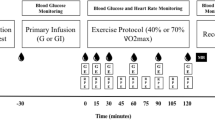Summary
The aim of this study was to provide information concerning the mechanism of exercise-induced stimulation of growth hormone (GH) release in human subjects. For this reason serum GH as well as some hemodynamic variables and blood concentrations of noradrenaline (NA), insulin (IRI), lactate (LA), glucose (BG), and free fatty acids (FFA) were determined in seven healthy male subjects exercising on a bicycle ergometer with arms or legs and running on a treadmill at equivalent oxygen consumption levels. Significantly greater increases in serum GH concentration accompanied arm exercises than those observed during the leg exercises. This was accompanied by greater increases in heart rate, blood pressure, and plasma NA and blood lactate concentrations. Serum IRI decreased during both leg exercises and did not change during the arm exercise. There were no differences in BG and plasma FFA concentrations between the three types of exercise.
The role of humoral and neural signals responsible for the greater GH response to arm exercise is discussed. The findings are consistent with the hypothesis that neural afferent signals sent by muscle “metabolic receptors” participate in the activation of GH release during physical exercise. It seems likely that the stimulation of these chemoreceptors is more pronounced when smaller muscle groups are engaged at a given work load. However, a contribution of efferent impulses derived from the brain motor centres to the control system of GH secretion during exercise is also possible.
Similar content being viewed by others
References
Anton AH, Sayre DF (1962) A study of factors affecting the aluminium hydroxide trihydroxyindole procedure for analysis of catecholamines. J Pharmacol Exp Ther 138: 360–372
Berger M, Halban PA, Müller WA, Offord RE, Renold AE, Vranic M (1978) Mobilization of subcutaneously injected tritiated insulin in rats. Effect of muscular exercise. Diabetologia 15: 133–140
Buckler JMH (1973) The relationship between changes in plasma growth hormone levels and body temperature occurring with exercise in men. Biomedicine 19: 193–197
Casanueva F, Villanueva L, Penalva A, Vila T, Cabezas-Cerrato J (1981) Free fatty acid inhibition of exercise-induced growth hormone secretion. Horm Metab Res 13: 348–350
Coote JH, Hilton SM, Perez-Gonzales JF (1971) The reflex nature of the pressor response to muscular exercise. J Physiol (Lond) 215: 789–804
Davies CTM, Few JD, Foster KG, Sargeant AJ (1974) Plasma catecholamine concentration during dynamic exercise involving different muscle groups. Eur J Appl Physiol 32: 195–206
Few JD, Cashmore GC, Turton G (1980) Adrenocortical response to one-leg and two-leg exercise on a bicycle ergometer. Eur J Appl Physiol 44: 167–174
Glick SM, Roth J, Yalow RS, Berson SA (1965) The regulation of growth hormone secretion. Recent Progr Horm Res 21: 241–270
Hansen AP (1970) Abnormal serum growth hormone response to exercise in normal and diabetic men. J Clin Invest 49: 1467–1478
Karagiorgos A, Garcia JF, Brooks GA (1979) Growth hormone response to continuous and intermittent exercise. Med Sci Sports 11: 302–307
Kozłbwski S, Brzezinska Z, Nazar K, Kowalski W, Franczyk M (1973) Plasma catecholamines during sustained isometric exercise. Clin Sci Mol Med 45: 723–731
Lassare C, Girard F, Durand J, Raynaud J (1974) Kinetics of human growth hormone during submaximal execise. J Appl Physiol 37: 826–830
Longhurst J, Zelis R (1979) Cardiovascular responses to local hindlimb hypoxemia: relation to the exercise reflex. Am J Physiol 237: H359-H365
McCloskey DL, Mitchell JH (1972) Reflex cardiovascular and respiratory responses originating in exercising muscle. J Physiol (Lond) 224: 173–186
Mosinger F (1965) Photometric adaptation of Dole's microdetermination of free fatty acids. J Lipid Res 6: 157–159
Nilsson KO, Heding LG, Hökfelt B (1975) The influence of short term submaximal work on plasma concentration of catecholamines, pancreatic glucagon and growth hormone in man. Acta Endocrinol (Kbh) 79: 286–294
Stegeman J, Kenner Th (1971) A theory on heart rate control by muscular metabolic receptors. Arch Kreisl-Forsch 64: 186–214
Sutton JR, Jones NL, Toews CJ (1975) Growth hormone secretion in acid-base alterations at rest and during exercise. Clin Sci Mol Med 50: 241–247
Vigaš M, Nemeth S, Jurcovicova J, Mikulaj L, Komadel L (1974) The importance of lactate in exercise-induced growth hormone release in men. In: Luft R, Yalow RS (eds) Radioimmunoassay, methodology and applications in physiology and in clinical studies. Horm Metab Res [Suppl] 5: 166–169
Author information
Authors and Affiliations
Additional information
This work was partly supported by the Polish Academy of Sciences (project 10.4), and performed within the Scientific Exchange Programme between Medical Research Centre, Polish Academy of Sciences and Institute of Experimental Endocrinology, Slovak Academy of Sciences
Rights and permissions
About this article
Cite this article
Kozłowski, S., Chwalbińska-Moneta, J., Vigš, M. et al. Greater serum GH response to arm than to leg exercise performed at equivalent oxygen uptake. Europ. J. Appl. Physiol. 52, 131–135 (1983). https://doi.org/10.1007/BF00429040
Accepted:
Issue Date:
DOI: https://doi.org/10.1007/BF00429040




